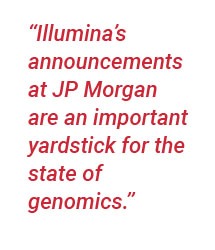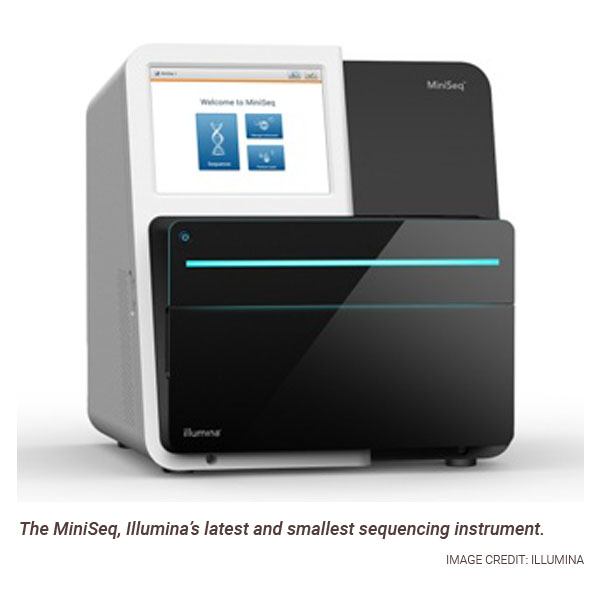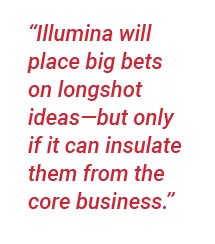Jolly Jay Flatley Ushers in Another Big Year for Illumina
By Aaron Krol
January 12, 2016 | The JP Morgan Healthcare Conference comes but once a year. Now it’s here, now it’s here, and Illumina CEO Jay Flatley has honored his seasonal tradition by releasing a new next-generation sequencer in his address to investors at the San Francisco event yesterday morning.
Illumina is not quite a monopoly power in DNA sequencing, and increasingly there are interesting reasons a lab manager might mull over instruments from competitors―like a PacBio Sequel for long DNA reads, a QIAGEN GeneReader for on-demand clinical tests, or an Oxford Nanopore MinION for the sheer sci-fi swagger of carrying a sequencer in your coat pocket. But at the nexus of price, accuracy, and volume, Illumina still sets the standard for what labs of all sizes can achieve with sequencing, so the company’s annual release of its pent-up creative energies at JP Morgan is an important yardstick for the state of genomics.
 This year, Flatley has unveiled the MiniSeq, Illumina’s most affordable sequencer yet. The instrument is a natural evolution of the product line. Two years ago, Illumina came out with an ingenious (though not universally loved) new chemistry system that uses just two dyes, in different combinations, to label all four DNA bases. This system let the company scale back from the bulky optics in its top-of-the-line HiSeq instruments, producing the NextSeq, a much smaller and less expensive machine that approaches the HiSeq’s speed and throughput.
This year, Flatley has unveiled the MiniSeq, Illumina’s most affordable sequencer yet. The instrument is a natural evolution of the product line. Two years ago, Illumina came out with an ingenious (though not universally loved) new chemistry system that uses just two dyes, in different combinations, to label all four DNA bases. This system let the company scale back from the bulky optics in its top-of-the-line HiSeq instruments, producing the NextSeq, a much smaller and less expensive machine that approaches the HiSeq’s speed and throughput.
The MiniSeq applies the same principle to the baby of the Illumina family, the benchtop MiSeq. Reengineering has not only worked in simplified optics, but also stripped out one of two valves and pump systems in the MiSeq. More importantly, Illumina has designed the MiniSeq to run with a single reagent cartridge, which can be shipped dry, making it the company’s easiest sequencer to start using. Library preparation is still a hurdle for first-time users, but once a DNA library is prepared for sequencing, it can simply be loaded onto the MiniSeq’s single flow cell, and inserted in the machine with a new reagent cartridge.
At just over 18 inches to a side, the MiniSeq is the smallest Illumina sequencer, and at $49,500, it’s half the price of a MiSeq―the first Illumina instrument to be priced in line with Thermo Fisher’s Ion PGM. Illumina says that runs on the MiniSeq will take 24 hours or less, depending on application, and paired-end read lengths will top out at 150 base pairs. With a high-output reagent kit, the instrument will be able to deliver a whole genome of a midsize bacterium at about 30x coverage―although a more likely application will be targeted gene panels, an area where Illumina sees heavier competition from Thermo Fisher.
Project Firefly
Nifty as it is, the MiniSeq is more a story of good engineering than a major scientific advance. A small sequencer along these lines would have been a safe bet for Flatley’s 2016 product reveal: Illumina’s dominance of ultra-high-throughput sequencing is basically absolute, and the company already had two-dye sequencing in its bag of tricks. (That said, Keith Robison of the Omics! Omics! blog deserves to crow a bit about his uncannily accurate prediction.)
But Flatley also broke with tradition this year, trumpeting a technology he doesn’t expect to release until 2017. (And mid-to-late 2017 at that: sorry girls and boys, but Jay Flatley might not bring you any big presents next JP Morgan Healthcare Conference.) The new product, tentatively named Firefly, will be Illumina’s first sequencer that doesn’t rely on optical readouts. Instead, sequencing will be done on complementary metal-oxide semiconductor (CMOS) chips, a technology Illumina has said precious little about since it bought up a related company, Avantome, almost eight years ago.
Semiconductor sequencing is a downright cool technology, and when Ion Torrent was preparing to introduce it to the market for the first time in 2010, many felt this new method of reading DNA might take over completely. Semiconductor chips are cheap to fabricate and highly scalable, and can register DNA binding events in real time.

The trouble is that electrical signals on these chips are binary. That makes sequencing, which has to differentiate between four different DNA bases, an awkward fit for the technology. Like Illumina, Ion Torrent (now owned by Thermo Fisher) uses sequencing-by-synthesis, adding new bases to the sample DNA and recording them as they attach. But while Illumina, with its fluorescent labels, can add all four bases to the mix at once and see which one incorporates, Ion Torrent has to add them one at a time and check whether they incorporate, slowing down the system.
Now, Flatley says, Illumina has worked out a “one-channel” way of identifying bases. This is a bit like the clever trick they pulled with the NextSeq and MiniSeq, encoding four bases in different combinations of two dyes―but how they’ve further reduced this to a binary signal, Flatley isn’t saying. However it works, apparently the Illumina lab has already demonstrated the technology on individual CMOS chips, with greater than 99% per-base accuracy. This, Flatley told investors during a Q&A session yesterday, is “a pretty monumental achievement, frankly.”

The next step will be to incorporate those chips onto an easy-to-use instrument.
Given the history of pre-announced sequencing product launches, everything Flatley said yesterday about Firefly should be taken with a grain of salt, the 2017 launch date very much included. But his ambition is to sell the system for under $30,000, which would include both a sequencer and a separate box for automated sample preparation. Each of these instruments will be roughly a 12-inch cube, and freed from the bulky and heat-generating optical systems of current Illumina sequencers, they will be stackable, so that labs can keep buying them without eating up their lab space.
Firefly’s throughput will be lower than the MiniSeq’s, but runs will be faster: it will produce about as much data per hour as a MiniSeq on mid-output mode.
Flatley says he had no choice but to jump the gun on announcing Firefly―its development will involve a substantial investment in 2016 and big changes to Illumina’s supply chain and manufacturing networks, all of which he felt was likely to tip off observers to the project.
Illumina’s sidestep into semiconductor sequencing is a nice reminder that genomics is blessed with one of the world’s better monopolies. Yes, more serious competition in DNA sequencing would be good news for pretty much everyone but Illumina. But if one company is going to have its fingers in virtually every sequencing lab in the world, at least it’s not sitting back raking in rent on its reagents. Whether it’s because of pressure from nanopore sequencing nipping at Illumina’s heels, or just a testament to the scientific talent the company has assembled, the world leader in sequencing is still sprinting to keep ahead.
The Rest of the Pudding
As usual, Flatley also previewed a smattering of other developments from the many arms of his company. He introduced a new, 96-sample bead chip called Infinium XT for Illumina’s DNA microarray business―increasingly an afterthought in the next-generation sequencing era, but still extremely useful for large-scale genetic research on the cheap. (Another sign of microarrays’ continued relevance this week was the astonishing $1.3 billion sale of Affymetrix, scooped up by Thermo Fisher at a 50% premium over the share price.) Infinium XT is set to ship in the second half of this year.
Another exciting hardware project is a partnership with Bio-Rad Laboratories to build a high-throughput device for single-cell sequencing. This is an area of huge scientific value, giving researchers a much finer-grained look at genetic activity in living tissue. But methods for isolating single cells, and preparing them for sequencing, are painstaking and highly specialized. The new partnership will merge a droplet partitioning system created by Bio-Rad with built-in sample prep from Illumina, giving users an automated instrument that will go from cell samples to sequencing-ready DNA libraries at a cost of around a dollar per cell.
Last year, Flatley’s address focused heavily on real-world applications, showing off the extent to which Illumina had evolved beyond being simply a hardware company. Illumina still wants to have at least some stake in most of the end uses for its machines: Flatley announced 2016 plans to launch a tumor sequencing panel for the NextSeq, a cancer RNA panel, and a CE-marked prenatal test in Europe. But the emphasis of his JP Morgan address this year was more on the kit than the clinic.
That probably reflects a growing willingness to spin out riskier businesses outside Illumina’s hardware core. Illumina launched its first independent company, Helix, in August, for the decidedly unproven business of consumer  genetics. The notion is that customers will get large portions of their genomes sequenced for well below cost, then pay to access that data through a variety of third-party apps. Flatley was able to announce yesterday that Duke University and Good Start Genetics have signed on as app vendors, joining the Mayo Clinic and LabCorp―but whether ordinary people will want to dip into their genomes enough times to keep Helix in the black is very much an open question.
genetics. The notion is that customers will get large portions of their genomes sequenced for well below cost, then pay to access that data through a variety of third-party apps. Flatley was able to announce yesterday that Duke University and Good Start Genetics have signed on as app vendors, joining the Mayo Clinic and LabCorp―but whether ordinary people will want to dip into their genomes enough times to keep Helix in the black is very much an open question.
Meanwhile, Illumina took another big swing over the weekend with the launch of GRAIL. (See, “Illumina Spinoff GRAIL to Trial Liquid Biopsies for Early Detection of Cancer.”) The premise of that company, to test seemingly healthy people for free-floating genetic markers of cancer in the blood, is both enormously tempting and painfully difficult. There are other liquid biopsy companies out there, but none aiming for cancer prevention. (With the rather shaky exception of Pathway Genomics.)
GRAIL expects to sequence samples at 1000x coverage to uncover trace amounts of tumor DNA, something that requires Illumina’s full resources. As Flatley told investors yesterday, “When we demonstrated internally how deep you had to sequence… we realized our customers couldn’t do this economically for a long time.” It seems the cost of this service, if it can prove itself in the clinic, will only be manageable with a steep discount on sequencing.
As 2016 opens, we’re starting to see an interesting new pattern for Flatley’s genomics giant. Proven applications stay in-house with the sequencers that make them work, with the hope that Illumina will be the go-to vendor as clinical sequencing continues to grow. Meanwhile, the company will place big bets on longshot ideas―but only if it can insulate them a bit from the core business, and raise some of the funding from venture capital.
The many starry-eyed biotech entrepreneurs gathering this week in San Francisco are probably taking notes. In 2007, Illumina was a secondary player in microarrays that vaulted over Affymetrix by predicting its own technology would soon go out of style. Now, with a market cap of $2.4 billion, the onus is on Illumina to capitalize on its lead. Whether the company’s restless activity pays off or not, you can’t fault them for not trying.


